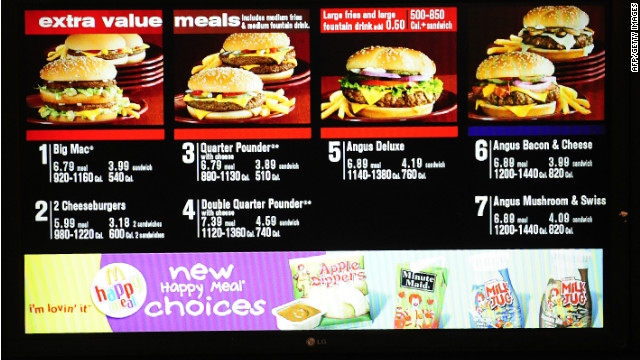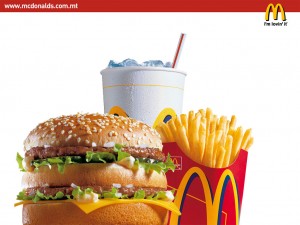
Good news: McDonald’s will soon be taking the initiative — in advance of a likely federal regulation that may be coming early next year — to post calorie information on its menu. Calorie information is already available from most fast food chains on their websites, and occasionally in paper leaflets available at individual stores, but is rarely obvious in a way as to inform the choices of the casual diner.
The decision announced today to start listing calorie information in an obvious way on McDonald’s menus will help empower diners make better choices, and likely without affecting McDonald’s bottom line. (Ater all, what diner is likely to actually leave a restaurant for another option based on the caloric information of their choices? Most customers will likely just choose a less calorically dense meal relative to what they walked into the restaurant for.)
But the question remains whether this move will alone be enough to improve the health of the average American. And the answer is most likely “no”.
The problem is that there’s a dearth of nutrition education in America, particularly among the working class and middle class customers that frequent fast food franchises. Even among Americans with a high school education or above, there’s a general ignorance over serving sizes, balanced diets, or even how to assess one’s individual caloric needs. Consider: there’s been quite a bit of discussion over school lunches and other food access concerns in public education, but relatively little discussion over how we properly educate students on nutrition. And for lower-class families, for whom there may not even be high school-level education, the chances that proper understanding of what caloric information means is even less.
For example, few Americans are aware that the 2000 calories per day rule of thumb, recommended by the FDA, is geared towards healthy adult men. In fact, USA Today reports in an article that 2/3 of those surveyed incorrectly reported their daily caloric needs, and that 25% wouldn’t even hazard a guess — this combined with a sidebar infographic from USA Today that woefully over-estimates the caloric needs for men and women of various age groups. It turns out that women and children — as well as men who may need to lose weight — require substantially fewer calories per day than the FDA recommended 2000 calories. For me, a moderately active woman standing at 5’2″, I only require about 1400-1800 calories per day, which I could consume in one sitting with a single McDonald’s sandwich.
Secondly, there’s simply too much emphasis on caloric information; yet a balanced diet requires additional information including fat and protein content for a meal. One could eat all one’s daily calories in Doritos and still not eat a healthy diet. Posting caloric information, without access (or public emphasis) on the other aspects of nutrition encourages consumers to think that hitting calorie marks is all one needs to eat properly.
These caveats aside, this is a good first step towards a more healthy America as well as a more empowered consumer base, and for that I applaud McDonald’s in its announcement today. The key to combating America’s obesity epidemic must lie in a more educated American consumer, and part of that comes from realizing that a Big Mac with large fries and coke is a whopping 2000 calories all by itself.

Related: Here’s Mayo Clinic’s Daily Calorie calculator, however I typically recommend that most people eat based on their basal metabolic rate (BMR) because 1) folks tend to under-estimate the calories they eat based on “serving size dysmorphia” (servings are actually much smaller than most of us realize so as a consequence people tend to eat more calories than they think they are), and 2) because activity level is often both over-reported and inconsistent from day-to-day. ExRx has a slightly less user-friendly calculator, but one that can distinguish both your BMR vs. your “activity-based” caloric requirements.
